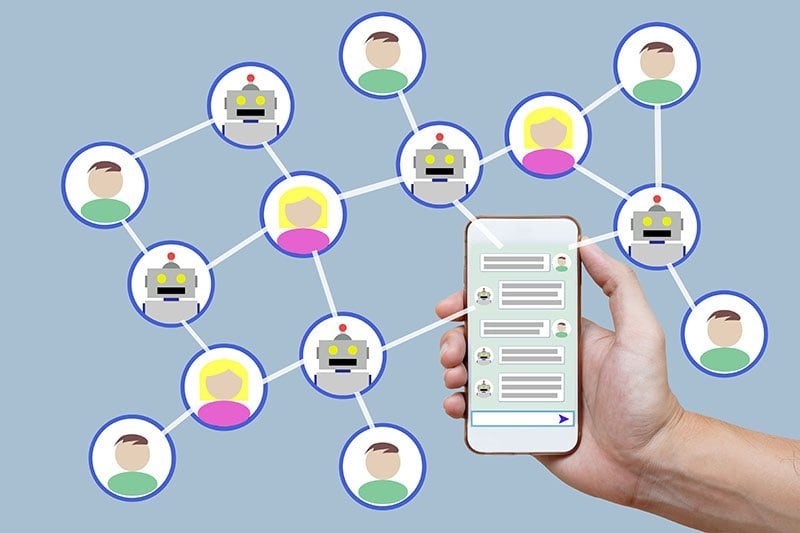You currently can’t escape all the talk of bots and, in particular, chatbots – computer programs that conduct conversations (with humans) via auditory or textual methods. The use of chatbots is quickly growing and it’s not just the consumer-world use – where Siri and Alexa are used to answer questions, play music, alter the home environment, or order physical and virtual products.
Chatbots are increasingly becoming the first line of support in business-to-business (B2B) and business-to-consumer (B2C) customer relationships. And the same will soon be true for internal IT support.
The Need for Speed and The Growing Use of Chatbots in a B2B and B2C Environments
Bots aren’t new – they are just receiving more media attention now. For instance, automated phone systems – which ask you to state your account number, or to verbally describe why you are calling, before passing you on to a human – have been around a while.
But now chatbots, more intelligent bots, are playing a part in the customer experience revolution – fulfilling what’s intended to be a customer-happiness-related need in addition to delivering more internally-focused benefits (such as cost savings or fulfilling customer-support needs when the available workforce is insufficient).
A big driver of this revolution is the continued customer expectation for speed, or even immediacy, of contact and resolution – industry research tells us that the best customer service is still fast, easy, and personalised.
However, the difference today, according to Loudhouse, is that customers have become less patient. In part, due to their personal-life ability to receive a speedy response from friends and family via social media apps – such as WhatsApp, Facebook Messenger, Snapchat, and Twitter – or even good-old-fashioned SMS. With this expected immediacy of response not just confined to social scenarios, it’s also applicable to their company-based (B2C) engagements too.
And now, thanks to consumerization – which is employees bringing their personal-life, consumer-world experiences and expectations into the workplace – the challenges of immediacy are hitting internal IT support teams too. Making chatbots an ideal opportunity for IT support teams to keep up with these ever-increasing employee expectations of speed and a better customer experience.
Chatbot Use in Customer Support
Customers can already engage with companies via chatbot facilities – on the company websites or via social platforms such as Facebook. They can ask questions related to product features, delivery times, pricing, or to seek support; and the chatbot will decide whether it can help (through the provision of automated answers) or if it needs to pass the customer, and the conversation to date, over to a human.
Or alternatively, as with the aforementioned phone system examples, the chatbot might only ever collect the information required by the human agent the customer will eventually speak with (having also been routed to the right type of agent).
Ideally though, the chatbot should have sufficient intelligence to interpret the customer’s questions and responses, and to pass back the most appropriate answers. Eventually delivering against the customer’s need, particularly when that need is for information. For example, AgentBot – a Zendesk partner – has an intelligent, natural-language engine which interprets customer questions and, in doing so, it understands grammatical/typographical errors, regionalisms, and the different ways the same question can be asked.
The Continued Exchange of IT and Customer Support Best Practice – it’s Chatbots Next
The IT support, and wider IT service management (ITSM), industry is currently focused on something called “enterprise service management” – the use of ITSM thinking, best practices, and enabling technology in other lines of business such as human resources (HR) and facilities. Plus, more recently, in customer service/support organizations for the servicing of external customers.
With the workflow automation, self-service, knowledge management, chat, and management reporting capabilities of ITSM tools a boon to parts of the business that might still be servicing their customers using emails, spreadsheets, and post-it notes (or focused, line-of-business technology that’s completely divorced of service and relationship management capabilities).
However, what isn’t always acknowledged, as part of this sharing, is that much of the customer-touchpoint or engagement technology used in ITSM first entered the business world via customer support teams – whether to improve the customer experience, reduce costs, or both. And definitely to help to win, retain, and grow customer relationships.
So, it’s now not unsurprising that external-customer support teams are leading the way in the use of chatbots for support and customer service, and it’s something else that IT support professionals should add to their toolkit.
Chatbots and IT Support
It might be a generalization but we do tend to like, if not love, our technology in IT support. That over the years we’ve continued to add new, technology-enabled ways of providing better IT support (and hopefully with greater efficiency and a lower costs). For example, help desk ticketing systems, ITSM tools, email-generated tickets, network discovery tools, knowledge management capabilities, remote control, monitoring tools, self-service portals, mobile apps, chat facilities, and many others.
Now chatbots, and machine learning, are about to join this long list. Why? Because everyone wins with chatbots:
- IT support benefits through having “additional team members.” Team members that don’t tire of the same questions being repeatedly asked and that never need sleep – providing for 24×7 operations and the potential to reduce costs while providing quicker support.
- Human IT support agents are freed up to do more complex and interesting work.
- Employees get the immediacy of response they expect (based on their personal-life experiences).
And even if these benefits are insufficient to spark your IT organization’s investment in chatbots for IT support, consider the impact of consumerization – employees are increasingly loving chat, research has proven this, so – again thanks to consumerization – chat will soon be a modern IT support necessity whether IT wants to provide it or not. Of course, it could be human-based chat; but if employees are comfortable using chatbots – and they might not be initially – why would you continue to invest in a higher-cost alternative, especially if 24×7 support is needed?
So, take a look at the possibilities with chatbots to see how they could be helping your IT support both now and in the future. You’ll probably be amazed at what they can already do.

